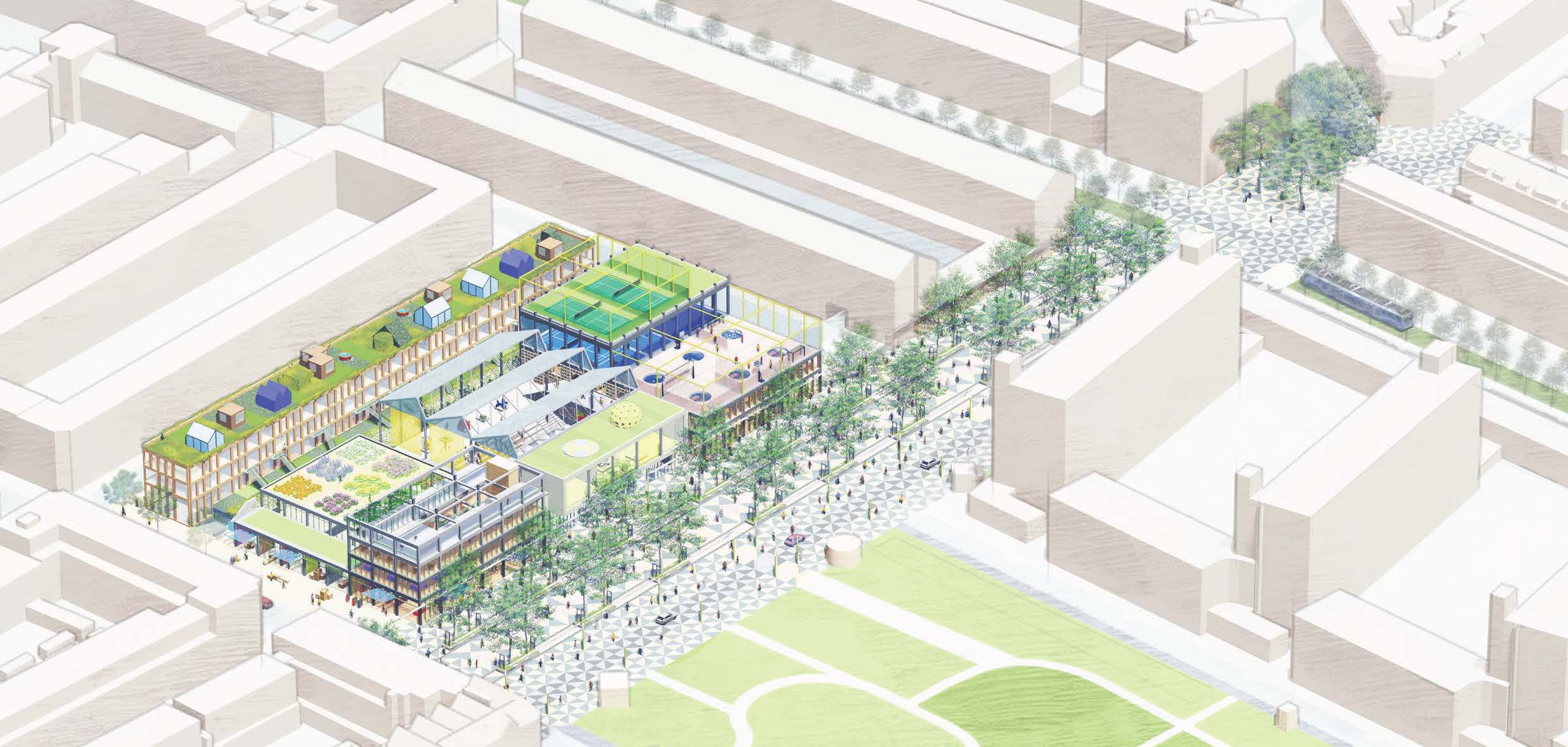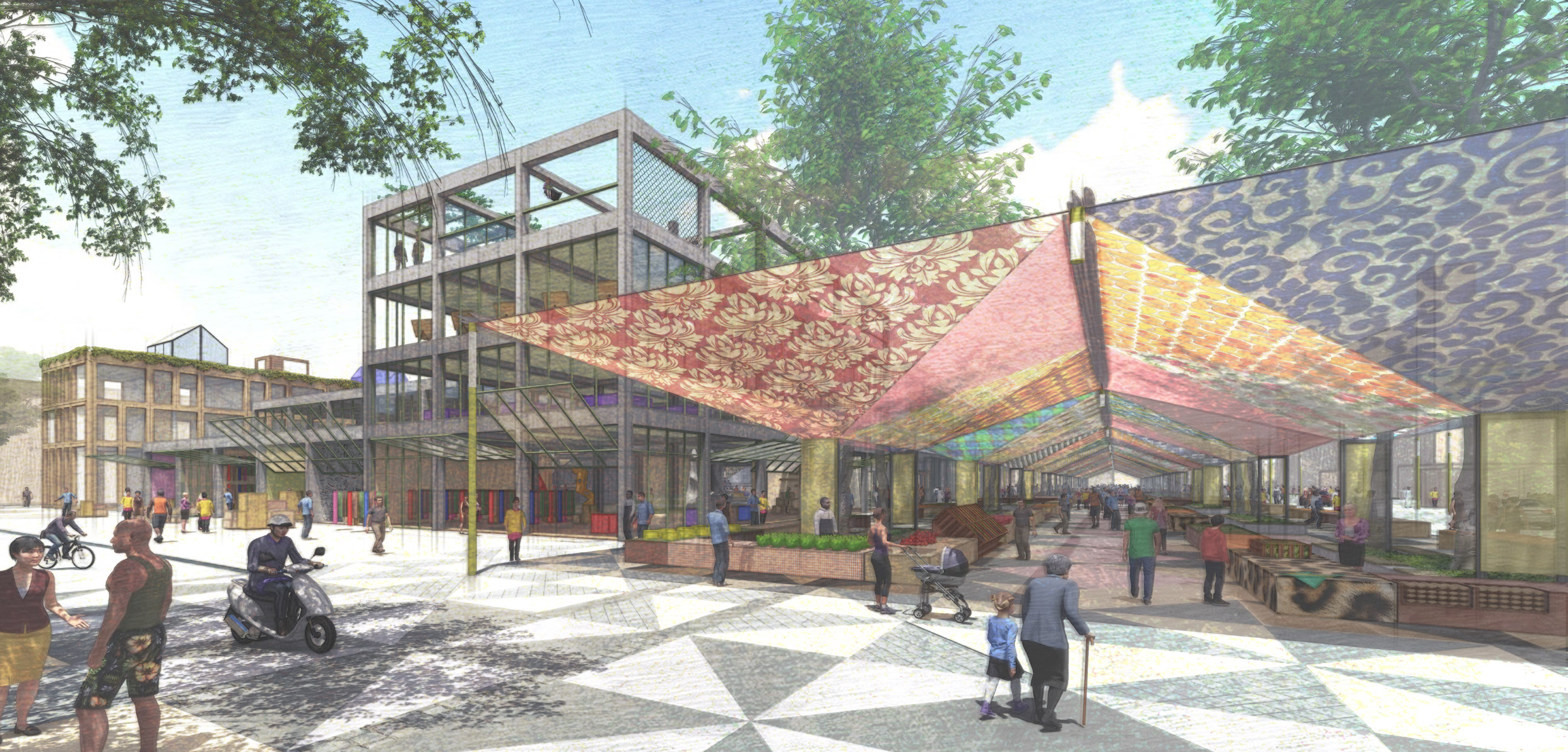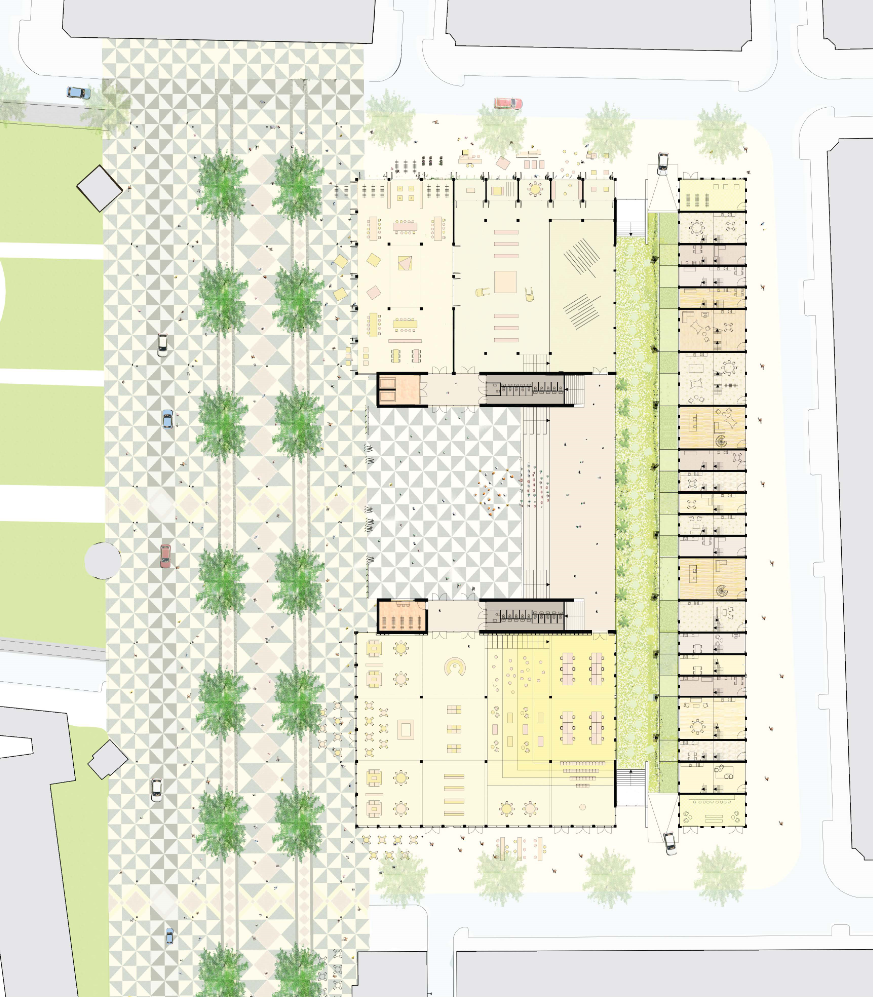Rambla + Kapsalon: Empowering People and Encouraging Collaboration

Rambla + Kapsalon
Render: Guillem Colomer
This proposal for Europan 15’s Visserijplein site in Rotterdam by Spanish Architect Guillem Colomer creates a central urban avenue to activate the surrounding neighbourhood with a dynamic coexistence of activities. The mutual interference of the new BOTU Rambla and the implanted multifunctional hub, create a stimulating collective image and identity with a multifaceted and authentic expression that represents the local community.
Interview with Guillem Colomer, Cofo Architects
Videography: Kristel Kuiper; Interview: Cullo Studio for AIR
THE RAMBLA
It is a social space where citizens can interact in new ways, stimulating their creativity and broadening knowledge. It provides a happy cultural landscape for a peaceful, open society in harmony with itself and with nature. It produces futureproof ecologies and a living environment that does not exploit its context but instead actively produces it. Furthermore, it is presented as a phased project that leads to a vibrant neighbourhood with a high level of mixed use and accommodates a broad range of activities, functions, people, building typologies, dimensions, tenures, and affordability.
The Rambla introduces a continuous urban stream that encourages a discovery of a varied collection of halls: it is a whole with multiple features that address the fluctuating identities of our contemporary societies. Democracy is equality among the different and it is the only collective means of resolving our greatest challenges. Democracy is always about people. People make places and create new identities, and cities are built by creating social networks. With this in mind, the Rambla has a leading role, because it creates spaces where people can meet.
The power of the halls resides in their capacity to absorb a perpetual state of revision since openness is a civic ideal, constantly renegotiable. There is a need to involve everybody in the dynamics of the world, demanding humanity. The design introduces the human scale to ensure that initiatives of social change happen, involving people in democratic participatory processes. Each of the halls explores the potential of different adaptive elements to promote unique interactions within users and public space.

Rambla + Kapsalon aerial
Render: Guillem Colomer, Cofo Architects
Producing infinite happiness
Productive development only makes sense if it fosters human happiness. The relations of production and distribution in society can only change if the culture changes as well. Architecture can play a fundamental role by defining a mindset by means of spatial compositions with strong expressions to influence individual mentality.
BOTU is a neighbourhood with vast diversity and multiple dynamics among its residents, entrepreneurs and organisations. It has an enormous potential to become a genuine neighbourhood by mobilising the rich diversity that it contains: people with all sorts of cultural backgrounds, languages, and skills. However, BOTU currently experiences a lack of high quality public space where such diversity can be enhanced and dignified.
People shape cities and cities in turn shape us. Instead of a strictly aesthetic expression, this proposal aims to generate a deeper impact. It aims to create a sense of community, so it proposes a system of connected public spaces that help to develop the local identity. This is a physical collective image that celebrates and expresses the rich diversity.

Rambla impression
Render: Guillem Colomer, Cofo Architects
“Third places” for collective exploration
This proposal asserts that the collective cause must be elevated. It supports the idea that at this point in European history, we must create proximities between people, to rejoice and to recreate a culture that respects diversity and expresses this profound Us. There is no innovation without connection. If encounters between diverse groups of people addressing related topics are encouraged, innovative approaches are fuelled because knowledge is exchanged and new insights are gained. Therefore related diversity must be increased.
The city is built by creating socialization networks. Third spaces exist between home (‘first’ place) and work (‘second’ place) where interaction and exchange can be stimulated productively. They establish a social safety net with diverse and inclusive cultural and educational offerings for everyone, which improves the perspectives of vulnerable residents.
In this proposal, architecture posits the collective exploration of knowledge with a glue that unites different people. As such, the project aims to develop the productive mind-set in BOTU by inserting the Next Economy into the public domain. Processes focused on discovering and making collectively will be implemented, leading to learning situations for all involved. This approach will allow the scope of the architectural action to broaden by creating moments when the program can be tested, the assumptions questioned, the potential verified, and mutual trust built.
A resilient system: open and specific
Spaces, both public and private, are currently being used in less predictable ways, mudding the role of planners and architects. This multifunctionality and changeability are essential in our fluid societies. Uses and requirements move at a faster pace than architecture. As such, this design focuses on the adaptability of the structure with regard to future use.
This proposal establishes an architectural specificity with programmatic indeterminacy in order to create an envelope that is capable of absorbing a perpetual state of revision. It must produce design for an uncertain future that can accommodate different time spans, always continuous and never closing, as well as an open and iterative process, where the aesthetics and structure manifest themselves in the course of its development.
The spatial diversity concept introduces the idea of a city within a city, a varied mosaic of differing conditions. Each space has a character all of its own, as regards ambience, finish, dimensions, light, view, spatiality. As a result, a neutral, multifunctional complex is avoided, and a kaleidoscopic labyrinth of distinctive locations results, each with its own specific possibilities of use.
The Rambla activates the potential of the site on multiple layers at once. It supports the neighbourhood’s diversity by creating a functional and spatial multidimensional framework. This resilient framework, combined with the Rambla’s green qualities, will act as a catalyst for social interactions and appropriation by the neighbours, resulting in generating a sense of identity among the residents of BOTU.

Rambla + Kapsalon impression
Section: Guillem Colomer, Cofo Architects
Neighbourhood backbone
The clear urban connections that the Rambla establishes will make it the backbone of the local economy. It will organise a transparent and recognizable infrastructure throughout the neighbourhood, fixing the missing links in the urban tissue, reorganizing the current traffic, and creating new connections to surrounding neighbourhoods. Emphasis is placed on the connection to the DakPark and the new M4H Makers district.
Permanent urbanity
The Rambla will stimulate social interaction and healthy living by reinforcing life on foot. It will be a pedestrian-priority street defining a clear hierarchy of foot and bike over cars. This will provoke a multitude of valuable social opportunities and unpredictable spontaneous actions, producing city. The Rambla organises the urban tissue and brings spatial hierarchy to the neighbourhood. In the following phases the Rambla will be totally surrounded by renovated, extended or new housing blocks with active plinths that strengthen its edges. Therefore its use and function will increase considerably over time.
Identity from the diversity
The Rambla will also also generates a unique kind of public space in the neighbourhood. It works 24/7, thanks to the simultaneity of its use. It acts as a well-connected green street of high spatial quality that combines necessary, optional and the social activities, and this encourages a constant and active flow of diverse people. On market days, the Rambla will become even busier as the market takes place in it.
The Market: public space at the heart of BOTU
The history of urban development illustrates how the oldest settlements were developed along paths, trails, and market places. Traders set up their tents and booths along the most popular paths in order to offer their wares to passers-by. Markets have always been crucial to urban life and space.
Local productive motor
The project aims to use the commerce use of the market as a trigger to initiate dynamics of change and transform the surrounding environment. The ecosystem of partners of the market should foster the local network, making sharing socially and economically feasible.
The pride of BOTU
The market and the offered products embody the multicultural character of the neighbourhood. A colourful canopy creates a unique temporary space that proudly celebrates this identity. It is made by the neighbours with different patterns and waterproof textiles, and expresses the cultural diversity of the neighbourhood.
Future proof
As mentioned previously, it is essential that the market can evolve to face future changes. New kinds of stalls can be established, and different zones facilitated. Because the market is no longer constrained by a square, it can grow following the Rambla towards the Dakpark, connecting two of the main public spaces in the neighbourhood.

Rambla + Kapsalon impression
Section: Guillem Colomer, Cofo Architects
THE KAPSALON
Rotterdam’s infamous “kapsalon dish” is a result of the city’s rich multicultural identity. Additionally, kapsalons (hairdressers or hair salon, in English) are intense productive places: as you work, you simultaneously build community.
The Kapsalon, as the three-halls building has been called, is a multifunctional hub for social activities, a central place for gathering and developing local initiatives, and a space to host small and large city events. In the same way as the kapsalon dish, the central space is a product of BOTU’s multiculturalism, combining elements of multiple cultures and the local identity.
The humanising events of engagement
The Kapsalon contains the public space that was missing in the neighbourhood: a covered square, a public interior. The central square is conceived as an urban extension of the internal life and use of the halls, overflowing with cultural and productive activities. This encourages the users to meet each other through multiple and simultaneous activities. The square maintains a human scale and a social field of vision due to its compact size: because people can read facial expressions up to a distance of 22m. The Kapsalon acts as a creative facilitator: an architectural frame where BOTU’s citizens can come together and establish the basis for a social laboratory in which pioneering methods and forms of urban coexistence can be developed and explored.
Changing Metabolism
An icon must be able to transform over time, to continue being relevant to the public and state-of-the-art. This everchanging urban place aspires to create synergies and new potentials for interaction. This needs to happen through a circular system: catalysing flows and processes in a more integral and resilient way. It is not a matter of technology only; it is the social imagination. The Kapsalon is a spatial machine that challenges us again and again to develop questions concerning the future of society. This ‘third’ space inserted between housing and production areas that can catalyse the transformation of current production cycles by creating synergies with urban areas and everyday life.
Living room for the neighbourhood
The Kapsalon confers the quality of a room, and bestows upon its occupants, and Rotterdam’s citizens, the pleasure of looking to the city from within, and at each other. In doing so, the building revives a special characteristic of the historic sheltering hall, and fashions a profoundly public space. It is a place shared by citizens, in which all are gathered together, in which all are equal, and all are other.
BOTUtsis
BOTUtsis are those who live or work or enjoy life in the BOTU neighbourhood. Everyone who lives in BOTU is, by virtue of residence, a BOTUtsis.
At the centre of this premis, is Aristotle’s belief that a “city is composed of different kinds of men, similar people cannot bring a city into existence.” The Kapsalon’s civic square involves the individual in the most comprehensive way in the dynamics of the world around them. It represents communal gatherings where everyone can participate in social and societal processes. It empowers residents of all ages on multiple levels and enables them to participate on strategic interventions on small scale for the community.

Kapsalon’s civic square
Plan: Guillem Colomer, Cofo Architects
Celebrate and enhance diversity
In order to ensure BOTU’s transition into the Next Economy, it is essential that the local community is empowered and works collaboratively. The public programme of Rambla + Kapsalon encourages interaction between the inhabitants. In this way, everyone is able to collectively take advantage of the Next Economy. Working as a collective and feeling represented by the neighbourhood’s identity improves social cohesion, and activates the common good. The process of the project places special importance on participation and reciprocity. This allows each member to know that his or her contribution will be valued and repaid. In this way, long-term relationships and bonds are created between neighbourhood, building, community, and individual.
Staying in the neighbourhood
A key factor in creating community is ensuring continuity in its inhabitants. It is essential not to break BOTU’s social tissue. Therefore, we must ensure that the neighbourhood housing is affordable and with green exterior space. The project proposes a housing bar at the site: a series of narrow units to maximize the number of doors towards the street.
In order to maintain the resilience of residents, it is also essential to improve the accessibility of learning environments and provide a local network of places with a mix of functions to learn, make, play, and work. The Kapsalon responds to these needs, and the Rambla enhances the connection with the adjacent neighbourhoods. The other key factor is having a public space that you can identify with and feel proud of. This is the foundation of the Rambla + Kapsalon proposal.
A better public space that works at three scales: the BOTU scale, public space scale, and human scale: because better conditions and a optimised use result in a better society.
Guillem Colomer (ES) – Architect
Rambla + Kapsalon Winner Visserijplein


